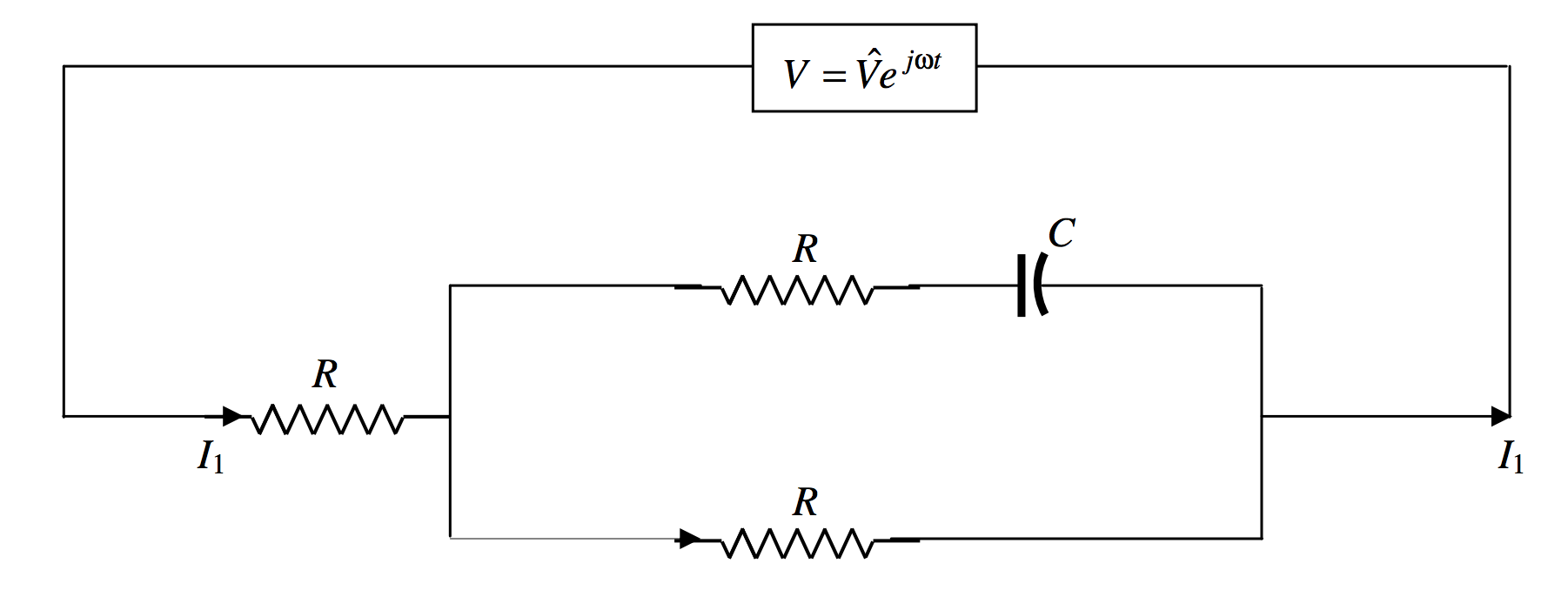13.6: Прийом
Взагалі імпеданс ланцюга частково резистивний і частково реактивний:
Z=R+jX.
Реальна частина - це опір, а уявна частина - реактивний опір. Відносини міжV and I is V=IZ. Якщо схема чисто резистивна,V and I are in phase. If is it purely reactive, V and I differ in phase by 90o. The reactance may be partly inductive and partly capacitive, so that
Z=R+j(XL+XC).
Дійсно, таку систему ми докладно опишемо в наступному розділі. Зверніть увагу, щоXC є негативним.
Іноді пишеться еквація???Z=R+j(XL−XC), in which XC призначена для представлення кількості без знаку1/(Cω). У цих приміткахXC покликана представляти−1/(Cω).
Зворотний імпедансZ is the admittance, Y .
Таким чином
Y=1Z=1R+jX.
І звичайно, так якV=IZ,I=VY .
Всякий раз, коли ми бачимо комплексне (або чисто уявне) число у знаменнику виразу, ми завжди негайно множимо верх і низ на складний сполучений, тому Equation\ ref {13.6.4} стає
Y=Z∗|Z|2=R−jXR2+X2.
Це можна написати
Y=G+jB,
де реальна частинаG, - провідність:
G=RR2+X2,
і уявна частина,B, is the susceptance:
B=−XR2+X2.
Одиницею SI для допуску, провідності та сприйнятливості є siemens (або «mho» у неформальній розмові).
Я залишаю це читачеві, щоб показати, що
R=GG2+B2
і
X=−BG2+B2.
Який імпеданс ланцюга нижче змінного струму частоти2000/π Hz (ω=4000 rad s−1) ?

Рішення
Думаю, що наступне буде з готовністю узгоджено. (Пам'ятайте, що допущення - це зворотний імпеданс; і, всякий раз, коли ви бачите комплексне число в знаменнику, негайно помножте верх і низ на сполучений.)
ІмпедансAB=(25−50j)Ω
ІмпедансCD=(40+10j)Ω
ПрийомAB=1+2j125 S=6+12j750 S
ПрийомCD=4−j150 S=20−5j750 S
Допустимість ланцюга =26+7j750 S
Імпеданс ланцюга =30(26−7j)29Ω
Струм веде по напрузі на 15º
Три резистора і конденсатор підключені доAC voltage source as shown. The point E is grounded (earthed), and its potential can be taken as zero. Calculate the three currents, and the potential at B.

Рішення
Ми можемо зробити це, використовуючи правила Кірхгофа звичайним способом. Коли я зробив це, я виявив, що алгебра трохи важка, і я виявив, що це було значно спрощено писати1Cω=aR, where a is a dimensionless number. Then, instead of writing the impedance of the section BDG as R−jCω, я пишу це якR(1−ja).
Правила Кірхгофа, застосовані до двох контурів і точкиB, are
V=I1R+I2R
I2(1−ja)−I3=0
I1=I2+I3
Ці рівняння мають бути розв'язані для трьох струмівI1,I2,I3. These will all be complex numbers, representing alternating currents. Solution could proceed, for example, by eliminating I3 з рівнянь\ ref {13.6.11} і\ ref {13.6.12}, а потім виключеніI3 з рівнянь\ ref {13.6.11} і\ ref {13.6.13}. Це призводить до двох рівнянь вI1 іI2. Ми можемо усунутиI1 їх, щоб отриматиI2. Я роблю йогоI2=VR(3−2aj), але потім відразу множимо верх і низ на,3+2aj щоб отримати
I2=(3+2aj9+4a2)VR
Потім просто повернутися до вихідних рівнянь, щоб отримати
I1=(6+2a2+aj9+4a2)VR
і
I3=(3+2a2−aj9+4a2)VR
Наприклад, припустимо, що частота і ємність були такимиa=1, що , то
I1=(8+j13)VR
I2=(3+2j13)VR
і
I3=(5−j13)VR
Таким чиномI1 призводитьV на 7º.1;I2 призводитьV на 33º.7; іI3 відстаєV на 11º.3.
Векторна (фазорова) діаграма для цих трьох струмів показана нижче, в якій фазон, що представляє змінну напругуV is directed along the real axis.

Маючи на увазі, що потенціал приE is zero, we see that the potential at B is just I3R and is in phase with I3.
Є ще один метод пошукуI1 , який ми зараз спробуємо. Якщо ми отримаємо однакову відповідь обома методами, це буде гарною перевіркою на можливі помилки в алгебрі.
Я заново намалюю принципову схему наступним чином:

РозрахуватиI1 we have to calculate the admittance Y of the circuit, and then we have immediately I2=YV. The impedance of R and C in series is R−jAR and so its admittance is 1R−jaR. The admittance of the rectangle is therefore 1R−jaR+1R=1R⋅[2−ja1−ja]. The impedance of the rectangle is R⋅[1−ja2−ja], and the impedance of the whole circuit is R plus this, which is R⋅[3−2ja2−ja]. The admittance of the whole circuit is 1R⋅[2−ja3−2ja]. Multiply top and bottom by the conjugate of the denominator to obtain 1R⋅[6+2a2+ja9+4a2]. Hence I1=VR⋅[6+2a2+ja9+4a2], which is what we obtained by the Kirchhoff method.
If you want to invent some similar problems, either as a student for practice, or as an instructor looking for homework or examination questions, you could generalize the above problem as follows.

Each of the three impedances in the circuit could be various combinations of capacitors and inductors in series or in parallel, but, whatever the configuration, each could be written in the form R+jX. Three Kirchhoff equations could be constructed as follows
V=I1Z1+I3Z3
V=I1Z1+I2Z2
I1=I2+I3
If I have done my algebra correctly, I make the solutions
I1=V(Z2+Z3)Z2Z3+Z3Z1+Z1Z2
I2=VZ3Z2Z3+Z3Z1+Z1Z2
I3=VZ2Z2Z3+Z3Z1+Z1Z2
Each must eventually be written in the form ReI+jImI, or (G+jB)V. For example, suppose that the three impedances, in ohms, are Z1=2−3j,Z2=4+2j,Z3=3−3j. In that case, I believe (let me know if I’m wrong, jtatum at uvic.ca) that Equation ??? becomes, after manipulation, I3=74+152j1429V. This means that I3 leads on V by 64º.0, and that the peak value of I3 is 0.118V A, where V is in V.
The potential at B is I3Z3. Both of these are complex numbers and the potential at B us not in phase with I3 unless Z3is purely resistive.
In composing a problem, you probably want all resistances and reactances to be of comparable magnitudes, say a few ohms each. As a guide, if you choose the frequency to be 500/π Hz, so that ω=103 rad s−1, and if you choose inductances to be about 10 mH and capacitances about 100μF, your reactances will each be about 10Ω.
You can probably also compose problems with various bridge circuits, such as

There are six independent impedances, so you’ll need six equations. Three for Kirchhoff’s second rule, to cover the complete circuit once; and three of Kirchhoff’s first rule, at three points. Good luck in solving them. Remember that, in an equation involving complex numbers, the real and imaginary parts are separately equal. And remember, as soon as a complex number appears in a denominator, multiply top and bottom with the conjugate. Alternatively, and easier, we could do what we did with a similar problem with direct currents in Section 4.12, using a delta-star transformation. We’ll try an example in Section 13.9, subsection 13.9.4.
